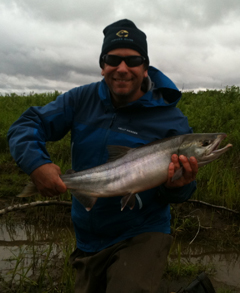There’s good news and bad news coming from Alaska and it doesn’t have anything to do with politics. First, the good news: it is wild salmon season. Wild salmon have just started to swim upstream to spawn and the fish are currently at their plumpest and tastiest. During their single-minded dash to reproduce, the salmon don’t eat and get skinnier as the season goes on.
Now for the bad news. The headwaters of the largest salmon run in North America are threatened by possible industrialization, according to Paul Greenberg, the author of Four Fish. According to Greenberg, a company called Anglo American is seeking to establish a copper and gold mine in Bristol Bay, “the breadbasket of Alaskan salmon.”
“In concentration, the mine, which is called Pebble Mine, is more sulfur than it is copper, so you can imagine just the tremendous impact all the slag from this mine could have on what is just a beautifully pristine area,” said Greenberg, pictured below with his first Bristol Bay catch of the year, a wild chum salmon from the Nushagak River. Greenberg claims that the copper from the mine also threatens the salmon’s migrating ability, which is partly based on smell. Approximately 40 million sockeye salmon travel through the Bristol Bay area each year — and sockeye are just one of five types of wild salmon native to the region.

For now, wild salmon stocks in Alaska are thriving and an environmentally responsible choice of seafood. “It’s now part of the Alaska state constitution that fisheries have to be managed sustainably,” said Greenberg, adding that almost all Alaskan fisheries are certified by the Marine Stewardship Council.
“With salmon, unlike a lot of fish, you really know how many there are and how many you can take. Why? Because salmon come into the rivers. We can literally count how many came in and figure out how many we need to let go by and get up river to spawn,” Greenberg said.
In terms of health, wild salmon provide a good source of protein, untainted with dyes or additives. “Certain species of salmon, particularly the sockeye salmon, are very, very low in toxins,” Greenberg noted. “Sockeye salmon eat very low on the food chain. They’re practically filter feeders. They eat little, tiny krill,” which means they are low in toxins and mercury.
The process of farming salmon has also improved in recent years. Greenberg explained that while it used to require six pounds of ground fish to produce one pound of wild salmon, that ratio is down to less than two pounds of feed for each pound of salmon. On the other hand, some farmed salmon still pose a threat to the environment, since the pens in which they are grown are sometimes placed in rivers where salmon migrate. The dense group of salmon then produce a large amount of waste and create a breeding ground for parasites like sea lice. Greenberg said that some salmon farms are starting to used containment methods to produce salmon, which keep the farmed versions out of streams.
When it comes to shopping at the grocery store, wild salmon like sockeye are easy to spot. With sockeye salmon, the flesh is evenly red, instead of a light pink, and it generally doesn’t have the white stripes of fat present in other farmed varieties.
Try New York Times writer Mark Bittman’s recipe for Salmon Roasted in Butter, from his book How To Cook Everything. "[This recipe] allows the natural complexity of wild salmon to come out," said Greenberg.
"Farmed salmon tends to have kind of a one-note, fatty-salmony flavor, whereas a wild sockeye has a spectrum of tastes. Because wild sockeye is naturally leaner than farmed salmon, the use of butter here works really well."
Salmon Roasted in Butter
From How to Cook Everything by Mark Bittman
Makes 4 to 8 servings
Time: 15 minutes
- 4 tablespoons (1/2 stick) butter
- 1 (2- to 3-pound) salmon fillet (skin-on is nice), preferably king or sockeye
- Salt and freshly ground black pepper
- Minced fresh parsley leaves for garnish
1. Preheat the oven to 475 degrees F. Melt the butter in a medium roasting pan-either on top of the stove or in the oven as it preheats -- until the foam subsides. Sprinkle the salmon with salt and pepper.
2. Put the salmon in the butter, flesh side down, and put the pan in the oven. Roast about 5 minutes, then turn and roast 3 to 6 minutes longer, until the salmon is done (peek between the flakes with a thin-bladed knife). Sprinkle with a little more salt if you like and serve.